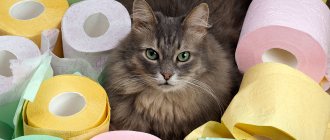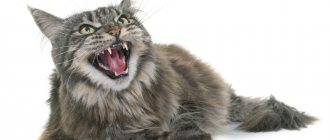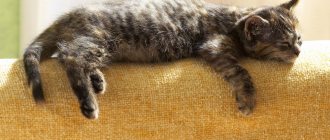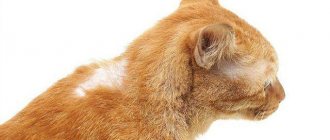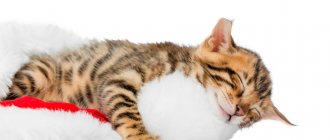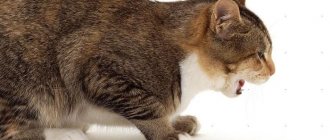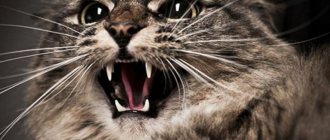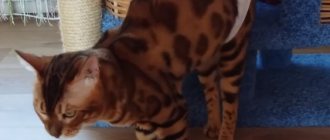Rhinitis in cats is often diagnosed. It can be either a sign of a mild illness or indicate severe disorders in the animal’s body. In most cases, inflammation of the nasal mucosa in a cat is short-term and does not cause severe discomfort to the animal.
With long-term manifestations of this pathological condition, the animal requires targeted treatment. This disease in a cat, if its course is unfavorable, can quickly become chronic.
Causes of runny nose in cats
All members of the cat family are distinguished by good health and good immunity. The appearance of rhinitis that persists for a long time in most cases indicates chronic diseases and other disorders that have a negative impact on the animal’s immune system. There are a number of factors that can provoke the appearance of a similar problem in a kitten or adult animal.
Cold
The most common cause of rhinitis in cats is the common cold. Viral rhinitis, caused by being in a draft or freezing, is more often observed in purebred cats that spend almost their entire lives indoors. Backyard animals living in private homes are more resistant to such effects. With an unfavorable course of viral rhinitis, lacrimation is observed. In addition, the animal's body temperature may increase, which is a sign of inflammation in the nasal cavity.
Allergy
Another common cause of a runny nose is allergies. Upon contact with an allergen, the animal’s nasal mucosa swells and excessive mucus secretion begins. This leads to severe narrowing of the lumen of the nasal passages and difficulty in nasal breathing. The allergic reaction is especially intense if the cat regularly comes into contact with the allergen. In this case, mucus may begin to secrete profusely from the animal’s nose. Nasal discharge can completely clog the nasal passages, causing the animal to sneeze.
Weak immunity
Most often, a runny nose due to weakened immunity is diagnosed in purebred cats with a long pedigree. Inbreeding, used to preserve the characteristic characteristics of the breed in the offspring, often causes genetic defects and poor health.
If you have a weak immune system, ordinary drops for the common cold, intended for children, do not give any effect. In this case, infectious diseases are constant companions of the pet. To maintain the health of a cat, a comprehensive examination and adequate treatment of the root cause of the pathology is required.
A foreign object got into the nose
A foreign body in a cat’s nose is extremely rare. This is due to the anatomical narrowness of the nasal passages. If a foreign body gets into the nostril, it will cause irritation and swelling of the mucous membrane. This may cause the development of rhinitis. In addition to a runny nose, the presence of a similar problem may be indicated by the animal’s frequent attempts to scratch its nose with its paw, as well as sneezing.
In most cases, increased nasal mucus production is enough to force the foreign object out of the nostril cavities. In rare cases, irritation caused by the presence of a foreign body leads to severe swelling and narrowing of the lumen of the nose, due to which the irritant cannot come out without outside help. In this case, directed assistance from a veterinarian is required.
Bacteria and fungi
Bacterial and fungal infections of the mucous membrane are most often observed in animals with weakened immune systems, incl. as a result of the natural aging process. Fungal infection of the mucous membrane often causes the development of a chronic form of rhinitis, accompanied by the secretion of rare transparent mucus.
With a bacterial infection of the nasal mucosa, the release of thick exudate is often observed, which can later form into thick crusts that interfere with normal breathing. With such damage to the nasal mucosa, it is necessary to use special treatment agents to suppress the activity of pathogenic microflora.
Parasites
Parasitic lesions of the nasal mucosa are extremely rare, but are always severe. In this case, both nasal passages are always affected, which prevents normal breathing. Due to the influence of parasites, the mucous membrane swells greatly.
In addition, there is copious discharge of colorless or yellowish mucus. In most cases, the presence of parasites in the nose leads to severe itching, which is why the cat rubs its head on various objects and often sneezes. Often, when examining an animal, an enlargement of regional lymph nodes is also detected. With parasitic infestation, symptoms of rhinitis can persist for a year.
Other Possible Causes
There are a number of other factors that can cause a cat to develop a runny nose. They are less common, so consultation with a veterinarian is required to clarify the nature of the problem. In rare cases, excessive mucus discharge from a cat's nose is the result of the formation of a tumor on the nasal mucosa. Such a defect is perceived by the animal’s body as a foreign body, which causes irritation, swelling and severe runny nose.
In addition, some types of infectious diseases can provoke the problem. Rhinitis is often accompanied by dangerous pathologies such as calicivinosis and rhinotracheitis. These diseases are accompanied not only by the appearance of purulent discharge from the animal’s nose, but also by an increase in body temperature, stool disorders and other manifestations. Among other things, the development of rhinitis is often observed against the background of such chronic diseases as:
- nephritis;
- diabetes;
- heart failure;
- urolithiasis, etc.
The inflammatory process on the nasal mucosa in a cat can spread from the auricle. Congenital anomalies in the structure of the nasal passages predispose cats to the development of rhinitis.
General and associated symptoms
Associated symptoms and treatment of a runny nose differ depending on the pathology that caused it. General manifestations of nasal discharge and sneezing may be accompanied by the following clinical signs:
- redness of the eyes;
- tearfulness;
- cough;
- ulcers on the oral mucosa;
- swelling and asymmetry of the muzzle;
- redness of the gums;
- sour eyes;
- protrusion of soft tissues from the nasal passages;
- snore;
- difficulty or noisy breathing;
- lack of appetite;
- weight loss;
- temperature increase;
- unpleasant odor from the mouth;
- lethargy, apathy.
It is important to carefully monitor your cat's condition when he has a runny nose and record any changes. This data will help the veterinarian find the true cause of rhinitis and prescribe the correct treatment.
Treatment
Features of therapy largely depend on the cause of rhinitis in the animal. To clarify the nature of the problem, you need to contact a veterinarian, who will be able to conduct the necessary research to identify pathogenic microflora, allergen or other cause of the problem.
Runny nose from hypothermia
If the cause of the problem is a cold caused by hypothermia, specific treatment for rhinitis in cats is not carried out. It is enough to keep the animal warm during illness and provide it with high-quality food. You can give vitamins. It is advisable to isolate the sick animal from healthy ones for the entire period of illness. In case of an unfavorable course, when there are signs of the addition of secondary microflora, rinsing the nose with a Tannin solution may be recommended. It is better if this procedure is carried out by a specialist.
Allergic runny nose
To effectively treat allergic rhinitis, you should first examine the animal to identify the type of allergen. To do this, it is necessary to protect the animal from contact with the allergen. This will reduce the severity of the disease. In severe cases, treatment should be supplemented with antihistamines in the form of tablets and injections.
Caring for a cat at home
Aftercare for your cat at home is paramount to the success of any treatment.
- Keep your cat warm.
- Use a humidifier (to reduce discharge).
- Offer food and water consistently.
For cats that lose their appetite, we can recommend food with a strong odor and plenty of liquid.
Extra care can greatly improve your pet's quality of life. These small steps provide comfort even to chronically ill people. If your cat refuses to eat, begins to lose weight, or has symptoms of dehydration, contact your veterinarian immediately.
How to treat a runny nose in a cat at home?
Considering that not all cat owners can take their animal to a veterinary clinic when signs of rhinitis appear, it is necessary to figure out how to carry out treatment at home. You can only use safe and proven products yourself. To eliminate nasal discharge during a cold, you can warm up the animal's nose using warm sand or salt packed in a small cloth bag. The warming up procedure should be carried out for at least 5 minutes 4-5 times a day.
A good effect can be achieved by instilling aloe juice diluted in a 1:1 ratio into the cat’s nostrils. Enough 1 drop in each nostril 2 times a day. If there are signs of dry nose, you can lubricate the nose with a 1% soda solution. In case of severe inflammatory damage to the mucous membrane, a small amount of Streptocide powder can be blown into the animal’s nostrils. During the entire treatment period, it is advisable to protect the animal from walks in the cold.
Prevention of rhinitis
The best protection against rhinitis is vaccination. While vaccines are the best defense against viral diseases, they are not 100% effective and the viruses that cause this condition are widespread.
- Vaccination of a cat before mating.
- Avoid exposing kittens to other cats until at least one week after the second vaccination.
- Frequent bedding changes (cat viruses are often spread through body fluids.
- Separate sick cats from healthy cats as soon as possible.
Cold drops for cats
For a runny nose caused by hypothermia, you can use some drops intended for people. Galazolin gives a good effect. These drops are designed for the treatment of children, but can also be used to gently relieve runny nose in cats.
In addition, if the runny nose is viral, you can use Anandin drops. This medication has not only an antiviral, but also an immunostimulating effect, which reduces the risk of the disease becoming chronic. Maksidin immunostimulating drops can be used with caution. The course of treatment with these medications ranges from 5 to 7 days.
Treatment of rhinitis caused by fungi, parasites and allergens
The fungal flora that most often provokes rhinitis is called cryptococcal. To eliminate it, Itraconazole, Fluconazole and other similar drugs are prescribed. The amount of medication depends on the weight of the cat, and the course of treatment is long and lasts at least a month. The first drug is prescribed at a dose of 5 mg per kg once a day. The second medicine must be given to the pet twice a day, 50 mg. The required amount must be dissolved in 1 tsp. boiled water and pour into the animal’s mouth on an empty stomach.
During therapy with antifungal drugs, a cat's appetite may worsen, digestive problems may occur, as well as nausea and vomiting. If such symptoms appear, you should notify your doctor to adjust the dosage.
Fluconazole is active against fungal flora
To eliminate a runny nose caused by parasites, special drops are used on the withers, which can get rid of helminths, as well as fleas, ticks and lice-eaters. Such products should be used once. After 24 hours, all parasites will leave the pet’s body. Drops are applied to the skin, spreading the fur in the withers area. Most often, Dironet, Prazicide, Bars and others are used for treatment. Drops applied to the skin are generally well tolerated. Only occasionally may the pet feel worse and become lethargic.
Dironet gets rid of parasites
If a symptom occurs against the background of an allergy, then it is important to identify the provoking factor and eliminate it. Antihistamines are also used additionally for treatment: Suprastin, Zodak, Tavegil, etc. It should be remembered that these medications do not eliminate allergies, but only relieve symptoms. It is enough to give the animal a quarter of a tablet per day on an empty stomach. The course of treatment should not exceed 7 days. When treated with antihistamines, the pet may appear lethargic, which is caused by a slight sedative effect. After discontinuation of the drugs, the animal’s condition returns to normal.
Tavegil relieves allergy symptoms
It is recommended to provide your pet with rest during treatment. It is important to protect your cat from stress, monitor its diet and prevent hypothermia.
How to rid a cat of a runny nose - video
How can a cold harm a cat?
In most cases, a cat's cold goes away without a trace within a week. However, such a favorable outcome is not observed in all cases. If measures are not taken in a timely manner, a critical decrease in immunity and the addition of a secondary infection are possible.
In addition, more severe complications may occur, expressed by inflammatory damage to the kidneys and respiratory system. In addition, inflammatory pathologies of the joints can develop against the background of a cold.
Diagnosis of the disease
At the veterinary clinic, the doctor will ask about all the manifestations of the disease - when the cat started to have a runny nose, what accompanying symptoms have appeared recently. Next, the animal is examined. The veterinarian will evaluate the nature of nasal discharge, the condition of the oral mucosa, teeth, and measure body temperature. Additionally, you may need to examine your cat's ears using an otoscope.
Already at this stage, the doctor can exclude some pathologies. If he suspects a viral infection, he will have to take a PCR test from the nasal passages, as well as a blood test. Culture of the discharge will help confirm or rule out a bacterial infection.
Additional research methods will help detect tumors in the nose and dental problems in a cat:
- X-ray of the skull;
- CT scan;
- rhinoscopy;
- x-ray of tooth roots;
- biopsy of tissue of the nasal cavity.
Since some studies are carried out under general anesthesia, you will additionally have to take a biochemical test of blood and urine, do a cardiogram and a chest x-ray. It is also necessary to determine blood clotting indicators. Such an examination will help the veterinarian choose the right drug for anesthesia.
Stages of nasal instillation
Before putting drops into the cat’s nose, you need to prepare the animal for the procedure. On this day he should not be disturbed. The pet should calm down and relax. The owner should understand that the cat will need to be held very tightly, because, regardless of the complexity of the manipulations, the animal will try to escape.
First you need to raise the animal's muzzle. You need to fix his head with your fingers. The container with the medicine should be taken in the right hand. The tip of the syringe or pipette should be brought as close to the nose as possible. Using gentle pressure, drop the prescribed amount of liquid into each nostril. After the procedure, it is better to immediately remove the instrument.
It is important not to press the bottle too close. From such a touch, the cat may begin to twitch even more. It is best to maintain a distance of up to 5 mm. Thus, using nose drops for a cat’s runny nose will be easy and painless for your pet.
It is best to choose a position and method of treatment based on the habits of your animal. Whether it is drops in the eye, nose or ear, it is worth first establishing a trusting relationship with the cat. The main thing is to let your pet understand that he has absolutely nothing to fear in this unusual situation.
Signs of a cold
Surely they will be:
- cough and sneezing;
- depressed, weakened state;
- green snot from one or both nostrils; breathes through the mouth (inhaling cold air outside can lead to respiratory illness!)
- increased body temperature;
- emergence of the third century; eyes water;
- decreased appetite.
Stages of nasal instillation
Before putting drops into the cat’s nose, you need to prepare the animal for the procedure. On this day he should not be disturbed. The pet should calm down and relax. The owner should understand that the cat will need to be held very tightly, because, regardless of the complexity of the manipulations, the animal will try to escape.
First you need to raise the animal's muzzle. You need to fix his head with your fingers. The container with the medicine should be taken in the right hand. The tip of the syringe or pipette should be brought as close to the nose as possible. Using gentle pressure, drop the prescribed amount of liquid into each nostril. After the procedure, it is better to immediately remove the instrument.
It is important not to press the bottle too close. From such a touch, the cat may begin to twitch even more. It is best to maintain a distance of up to 5 mm. Thus, using nose drops for a cat’s runny nose will be easy and painless for your pet.
It is best to choose a position and method of treatment based on the habits of your animal. Whether it is drops in the eye, nose or ear, it is worth first establishing a trusting relationship with the cat. The main thing is to let your pet understand that he has absolutely nothing to fear in this unusual situation.
Main reasons
In fact, sneezing is not always a consequence of any serious illness. Often animals in this way try to clear their nasal passages of an unpleasant odor or a foreign body that could accidentally get there.
A runny nose can occur against the background of any inflammatory process that occurs in the cat’s nasal cavity. This, as a rule, is always accompanied by increased mucus production. This phenomenon is absolutely natural, since the body fights the disease and tries to remove microbes. After this, the substance dries, becomes crusty and acquires a characteristic brown tint.
If treatment is not started in a timely manner, the discharge may become purulent. In addition, tissues may swell greatly, capillaries may burst, and blood streaks may be observed in the released mucus.
Several reasons can cause a runny nose; they can be divided into groups:
- non-communicable diseases;
- infectious diseases.
Before you begin treating your pet, it is worth identifying the root cause of rhinitis and eliminating it. Otherwise, the snot will soon return.
If the discharge is transparent, then there is no need to worry too much. But if blood is detected, then it is necessary to urgently seek advice from a veterinary clinic. These symptoms may occur due to bleeding caused by an injury. Bloody snot can also signal more serious problems, such as cancer.
The nose is the main organ of smell in a kitten, so under no circumstances should there be a runny nose. At the first signs of rhinitis, it is necessary to immediately begin treatment.
The following can cause sneezing and a runny nose in a cat:
- allergic reactions to food or chemicals;
- prolonged exposure to the street in cold or rain;
- the presence of microbes or parasites in the nasal cavity that cause discomfort;
- the presence of heartworms, which can appear after the bite of a mosquito that carries this disease;
- an infectious disease that a pet can contract from its relatives on the street or from the shoes of its owners.
The cause can be identified by the appearance of the mucus; it can be light and transparent, or it can have a green tint. Thick green discharge indicates that rhinitis is severely advanced. If you don't take action, it can turn into sinusitis.


